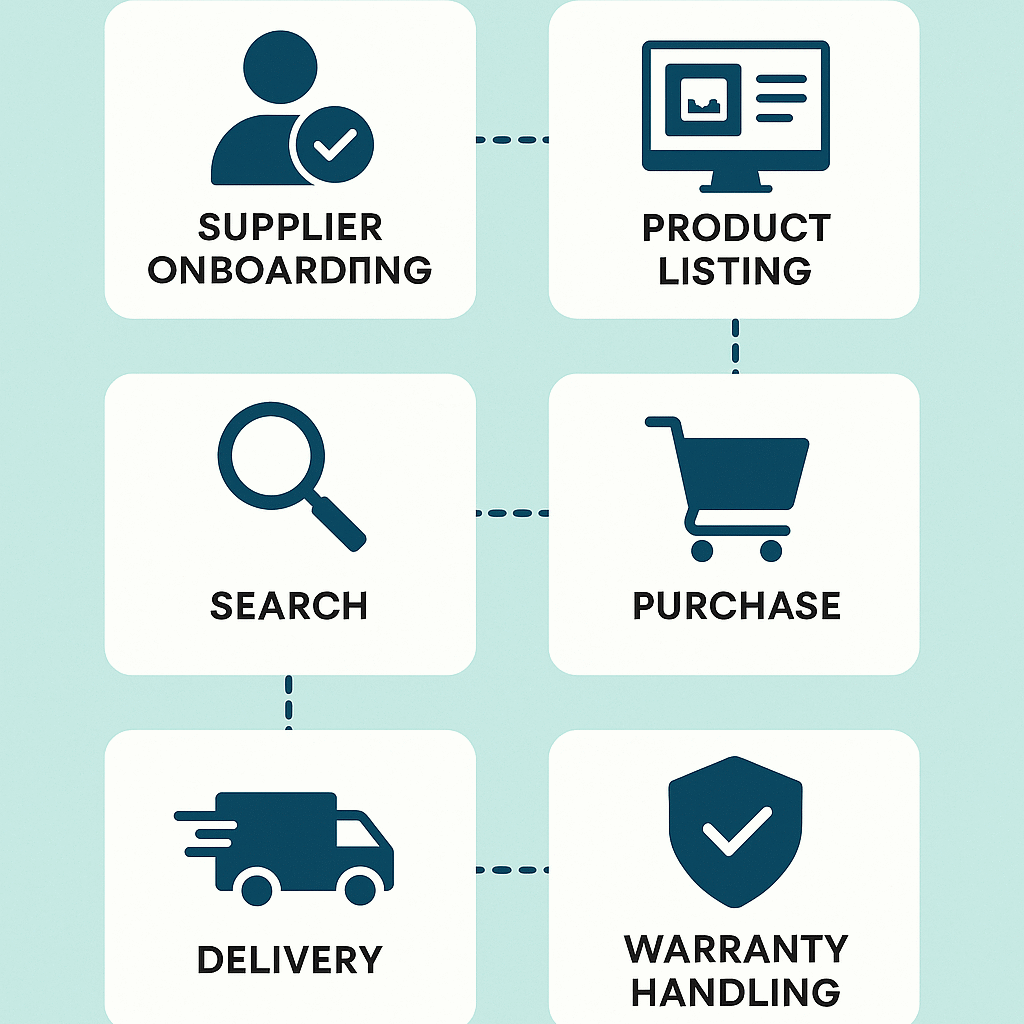When Every Minute Costs Thousands: The Real Story Behind Aviation Downtime
Picture this: It’s 3 AM at Dubai International Airport. A Boeing 777 sits grounded on the tarmac, its passengers transferred to hotels, and hundreds of connecting flights disrupted. The culprit? A $500 hydraulic valve that should have been routine to replace.
But here’s the kicker – that part is sitting in a warehouse in Germany, another is available in Texas, and a third supplier in Singapore has it in stock. The problem? Nobody knows this. The maintenance crew is making desperate phone calls, sending emails into the void, and watching the clock tick as each hour costs the airline $10,000 in lost revenue.
Sound familiar? If you work in aviation, you’ve probably lived this nightmare.
In the aviation industry, every grounded aircraft isn’t just an inconvenience – it’s a financial hemorrhage. Whether it’s a commercial airliner packed with passengers or a cargo plane carrying time-sensitive freight, delays in sourcing parts create a domino effect that touches everyone from airline executives to everyday travelers.
The frustrating part? This crisis often isn’t about part availability – it’s about finding the right part fast enough.
The Real Problem: Why Finding Aircraft Parts Feels Like Searching for a Needle in a Digital Haystack
Let’s be honest – the aviation spare parts market has been stuck in the stone age. While you can order almost anything on Amazon and have it delivered tomorrow, finding a critical aircraft component still involves playing phone tag with suppliers across three time zones.
Here’s what a typical parts search looks like today:
Monday, 9 AM: Your A320’s auxiliary power unit fails. You need part number 331A32-1007-02.
Monday, 9:15 AM: You call your primary supplier. They’re out of stock but will “check with their network.”
Monday, 11 AM: Still no callback. You start googling and find 12 different suppliers who might have it.
Monday, 2 PM: You’ve sent emails to 8 suppliers. Three haven’t responded, two don’t actually have it, and three want to “get back to you with pricing.”
Tuesday, 10 AM: Finally! One supplier has it, but they’re in Germany, don’t ship internationally, and only accept wire transfers.
Wednesday: Your aircraft is still grounded. Passengers are furious. Your boss is asking questions.
This isn’t just inefficient – it’s insane.
The aviation spare parts market suffers from four major headaches that keep maintenance teams up at night:
1. The Great Parts Hide-and-Seek Game – Why Aircraft Spare Parts Search Is Broken
Searching for aviation parts today feels like trying to find a specific book in a library where nothing is catalogued. Every supplier uses different part numbering systems, different websites, and different ways of describing the same component.
You might spend hours discovering that the “hydraulic actuator valve” from Supplier A is identical to the “servo control valve” from Supplier B – but only after calling them both and comparing technical specifications line by line.
2. The “Small Fish, Big Ocean” Dilemma in Aviation Supply Chains
There’s a brilliant MRO shop in Oklahoma that specializes in vintage Boeing parts. They have exactly what you need, at a great price, and they’re certified and reliable. The problem? They’ve never heard of your airline in Dubai, and you’ve never heard of them.
Meanwhile, you’re paying 40% more to a distributor who sources from that same Oklahoma shop – if you’re lucky enough to find them at all.
3. The Regulatory Maze Nobody Talks About
Every aviation part comes with more paperwork than a mortgage application — certificates of conformity, airworthiness documentation, export licenses, import permits. Each country has different rules, different forms, and different approval processes. Miss one piece of paperwork, and your $50,000 engine component becomes an expensive paperweight.
4. The Ticking Clock Pressure
While you’re playing detective trying to track down parts and navigate regulations, your aircraft sits on the ground burning money. Every hour of delay means:
- Lost revenue from cancelled flights
- Passenger compensation costs
- Crew overtime expenses
- Potential cascade delays across your network
- Reputation damage that’s hard to quantify
The aviation industry loses billions annually not because parts don’t exist, but because we can’t find them fast enough.
The Solution: Custom Aviation E-Commerce Platforms
This is where the next generation of aviation e-commerce marketplaces changes everything — replacing late-night phone calls with real-time global search, verified supplier networks, and automated compliance workflows.
Generic e-commerce platforms can’t meet aviation’s regulatory, operational, and technical demands. Custom-built platforms can.
Key aviation-specific features include:
- Verified supplier onboarding with certification checks.
- Advanced search by part number, manufacturer, keyword, or compatibility data.
- Real-time inventory synchronization with supplier databases.
- Built-in compliance modules for safety and export regulations.
- Multi-tier dashboards for suppliers, customers, and admins.
As outlined in our Software Requirements Specification (SRS):
“Suppliers must have the capability to list their aerospace products with detailed specifications, high-quality images, pricing, and availability status… enabling buyers to make informed decisions.”
Case Study: A UAE-Based Aviation Marketplace
When a UAE-based aviation company approached us, they faced familiar challenges: disjointed supplier communications, outdated manual processes, and limited market visibility. Their goal? Create a centralized, global e-commerce hub for aircraft spares.
What We Built:
- Unified Search & Browse – Instant location of parts by part numbers, categories, or filters.
- Auction Module – Competitive bidding to drive better pricing and engagement.
- Integrated Payment Gateway – Secure, multi-currency transactions.
- Courier Service Integration – Real-time shipping rates, tracking, and delivery.
- Warranty Claim Automation – Simplified returns and repairs.
- Market Insights Dashboard – Top-selling products and live market trends.
The auction dashboard became a standout:
“Suppliers will have the capability to arrange and host auctions… specifying starting bids, reserve prices, and bidding rules. This functionality will facilitate dynamic pricing strategies and engage potential buyers in competitive bidding environments.”
Results:
- Reduced procurement time from days to hours.
- Expanded supplier reach from regional to global.
- Improved customer satisfaction with transparent order tracking.
- Scalable architecture ready for AI integration.
As we stated in our presentation:
“This one-stop shop will streamline the process of locating scattered spares… and let the world know about their potential.”

Why Aviation E-Commerce Needs Custom Development Aviation platforms must address:
- Regulatory Compliance – Meeting global aviation authority standards.
- System Integration – Linking MRO and OEM databases for real-time updates.
- Scalability – Serving multiple regions, languages, and currencies.
- Security – Encryption, secure payments, and role-based access.
Future Trends in Aviation E-Commerce
1. AI-Powered Predictive Demand Forecasting
Machine learning will anticipate parts demand based on fleet usage and maintenance schedules.
2. Blockchain for Parts Authenticity
Tamper-proof records of manufacturing origin, repair history, and ownership.
3. IoT-Driven Maintenance Insights
Real-time part condition data triggering automated procurement.
4. Global Marketplace Expansion
Multi-lingual, multi-currency platforms reaching every aviation market.
Our Phase 3 roadmap:
“The integration of artificial intelligence… has revolutionized the industry, enhancing efficiency, customer engagement, and overall profitability.”
Conclusion: The Future Is Centralized, Digital, and Global
The aviation industry doesn’t have to tolerate fragmented procurement any longer. Custom e-commerce platforms built for aviation offer a secure, scalable, and intelligent way to connect suppliers and buyers worldwide.
Frack Tech has already proven it can design and deploy these solutions — solving today’s challenges and preparing for tomorrow’s innovations.


